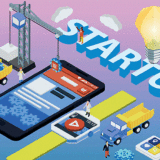What imagination can Biotechnology as a teacher bring to Artificial Intelligence?
by Ready For AI · April 23, 2020
In the future, Biotechnology and Artificial Intelligence will turn super-powerful machines and monkeys with brain expansion into our assistants? Together, Biotechnology and AI can lead to breakthroughs in fields such as personalized medicine, gene editing, and synthetic biology, revolutionizing the way we approach healthcare and scientific research. As technology continues to evolve, the potential for collaboration between biotechnology and AI is limitless.

Lessons from the Forefront of Artificial Intelligence and Biotechnology
Biotechnology is a vast field encompassing many areas, but our focus today is on those advancements that can be leveraged by AI. The intersection of biology and technology is a delicate one. While all advanced intelligence originates from living organisms, there are still many mysteries to uncover. For instance, we cannot yet explain why caterpillars curl up in response to external stimuli. Consequently, in developing technology, we may intentionally or unintentionally mimic biological traits. However, the results are not always successful. Brain-like computing that imitates the human brain has not progressed as expected, but a series of algorithms inspired by ants and other creatures have proven to be highly valuable.
For a long time, the application of biotechnology in AI has remained somewhat vague. Academia has also engaged in some unproductive endeavors, such as using significant computational power to simulate a protozoan amoeba simply to observe how nerve cells transmit signals. However, recent research progress suggests that the once useless theories of biological science may be re-written to benefit AI.

Advances in Understanding and Controlling Biological Perception
The interconnectedness of brain science, neuroscience, and AI is rooted in the quest to understand the ultimate problem of how consciousness arises. The ability of humans and animals to recognize and react to their environment remains a mystery, but advancements in biological perception systems are shedding new light on this topic.
For instance, Duke University researchers have made significant strides in replicating the strong sense of smell found in animals. By extracting olfactory receptors from animal stem cells, they discovered that 2% of human genes are used for olfaction, compared to 5% in dogs and mice. The researchers overcame the differences in animal genes to cultivate olfactory living cells, which they kept activated in a liquid medium.

This breakthrough means that, in the future, a few drops of liquid could provide humans with the same sense of smell as drug dogs or truffle pigs. Although the ultimate questions about consciousness remain unanswered, these developments in biological perception systems provide exciting possibilities for future research and practical applications.
Advances in the Imitation of Biological Abilities
Although some may argue that bionics is not the way to develop AI, it cannot be denied that imitating animals is crucial to the advancement of AI. Boston Dynamics’ robot dogs and insects are prime examples of animal replication in AI development.
Recently, researchers have not limited themselves to imitating regular animal species such as cats and dogs, but have also extended their studies to reptiles. For instance, scientists at the University of Queensland School of Biological Sciences studied how lizards walk on two legs after emptying their upper body. They discovered that the lizard’s tail played a significant role in balancing the animal and maintaining its speed. This finding could help researchers add tails to quadruped robots to improve their movement on different terrains.

Meanwhile, Stanford University is interested in the gecko’s hearing system, which is unique because the animal’s head is too small to triangulate the position of noises based on the distance between its ears. Instead, the gecko has a small tunnel on its head that reflects sound waves to determine the direction of the noise. Researchers have applied this method of micro-reflection to create a photodetector that can record light angle, color, and polarity. In the future, this technology may be used to replace bulky radars in self-driving cars.
Overall, advancements in the imitation of biological abilities are becoming more and more unique, opening up new possibilities for the development of AI.
Combining Biology and Technology for a Better Future
As we continue to explore the mysteries of biology, we are finding new ways to combine it with technology for a better future. Bionics, the imitation of biological abilities, is becoming increasingly unique and indispensable for the development of AI. Boston Dynamics’ robot dogs, for example, closely replicate the movements of real dogs and insects.
Our imitation of animals is not limited to traditional domesticated pets like cats and dogs. Researchers at the University of Queensland School of Biological Sciences are studying how lizards walk on two feet and maintain balance, using this knowledge to create quadruped robots that can cope with a wider range of terrain. Meanwhile, Stanford University is studying the gecko’s unique hearing system, which uses a small tunnel on its head to determine the direction of sound waves. This technology could potentially be applied to self-driving cars as a replacement for current, bulky radars.

In addition to bionics, our understanding of other aspects of biology is also being combined with technology. Researchers at Pennsylvania State University have discovered a protein in plants that tightly binds to metals, which could help us find more rare earth resources.
Nature has always been the source of inspiration for human beings, and as we continue to learn from it, we can give AI much more than just technical advancements. Biology can give AI an “intergenerational education” that benefits not only our technology but also the planet as a whole.
Exploring the Intersection of AI and Biotechnology: The Biopunk Frontier
The biopunk movement, with its vision of transforming life with technology, is not far from becoming a reality. As the fields of AI and biotechnology continue to evolve, what progress can we expect from their combination? Here are some potential advancements:

- Deeper Understanding of Biology for Advanced Robotics: Animals have undergone countless rounds of screening and evolution, developing highly adaptable behavior patterns that are closely attuned to nature. By studying and imitating these biological motion models, future robots could become more versatile and adaptable to different scenarios, such as navigating pipes, slits, and vertical walls.
- Making Better Use of Biology with AI: Rather than creating robots that merely mimic life, the biopunk vision is to transform and augment life with technology. For example, researchers are exploring ways to create brain interfaces that enable barrier-free communication between humans and animals, with the goal of developing more advanced animal intelligence. Additionally, scientists have developed a non-invasive sensor that helps collect comprehensive agricultural data from bees.
- Expanding AI’s Perception with Biological Patterns: Current AI perception methods, such as image and speech recognition, are largely based on human perception. However, animals possess unique perception patterns, such as a stronger sense of smell and richer color perception, that could expand AI’s capabilities. Researchers have attempted to study and replicate the visual mode of fruit flies to create a neural network that mimics their vision.

In summary, the intersection of AI and biotechnology holds great potential for transformative advancements in the future. As we continue to explore the biopunk frontier, we may discover new ways to harness the wisdom of animals and combine it with our own, creating a new era of innovation and progress.

















